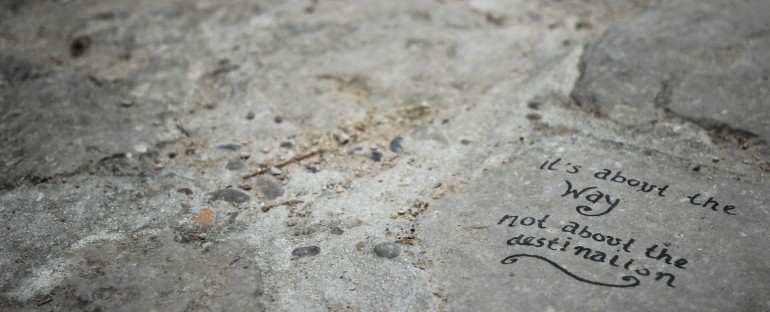Our lives appear to be a journey through time and space from birth to death. It seems we came from somewhere and are going somewhere as we live out the archetype of the pilgrim, the sojourner here on Earth. The strange thing is most of us don’t know where we came from, how and why we got here, or where we’re going.
The spiritual quest starts as a search for answers to these fundamental questions. This quest is often referred to as a spiritual path. Of course, it’s not really a path in the sense of moving from one place to another. The mind conceptualizes spiritual evolution as a journey with a destination, with a beginning and an end. We believe we will finally arrive somewhere else. But the spiritual path is a journey of consciousness—from ignorance to wisdom, from illusion to reality, from time-bound to timeless. Rather than traveling from here to there, it is an ever-evolving process of expanding and deepening our awareness. Ultimately, both the questions and questioner disappear.
There are many types of paths in this world–straight, narrow, winding, rocky, well-worn, and Robert Frost’s “road less traveled”–all leading from here to there. And all can be seen as metaphors for our unique life journey which is our path to awakening. There are paths throughout the world leading to sacred pilgrimage sites. Along these routes, pilgrims undergo profound transformations as they face hardships and experience a type of deep introspection that we don’t ordinarily encounter in our everyday lives. The movie, “The Way,” for example, depicts the experiences of a group of diverse people hiking the Camino de Santiago in the Pyrenees to the shrine of Saint James, each in search of healing some aspect of their lives. There is power in pilgrimage as the paths are sanctified by centuries of seekers and are steeped in their deep, heartfelt intentions.
Every time I boarded the plane to India, I saw the journey as a pilgrimage to a place that represents the wisdom of enlightenment. And there were pilgrimages within India, too. I remember the path leading to a cave in South India where the great spiritual master, Ramana Maharishi had meditated for many years. It was a long, winding stone footpath up the mountain. I was amazed to find myself there after years of practicing Ramana’s teachings and wishing I could visit his ashram.
Arriving at the foot of the mountain, my companion and I were approached by a guide who offered to take us to the cave. We were totally unprepared. It was unbearably hot, and besides both of us being sick with a respiratory flu, we had had no food or water before starting the journey. But no matter what the conditions were when we stepped foot on the pathway, it was a sacred journey, a pilgrimage, the fulfillment of a long-held desire.
As we followed our guide, I contemplated how although it was a route to a destination—the cave—it represented a path to liberation. Seekers hoped to follow in Ramana’s footsteps, both literally along the stone pathway, and figuratively to reach enlightenment. The master, who had guided his followers on their journey of awakening, had often climbed to the cave along this same path. Countless seekers, fellow sojourners had traveled it. It was well-worn. The way to liberation, on the other hand, is a “road less traveled.”
In India, it is recognized that there are many spiritual paths leading to awakening including the path of knowledge, the path of devotion, and the path of service. Like the pilgrimage routes, these paths to liberation are ancient and well-traveled. But unlike the outer paths leading through space and time, following the spiritual path requires stepping into the here and now, which is why it is known as the “pathless path.” No matter what spiritual path we are following, and what teachers and practices guide us along the way, it is our journey to experience fully, with all it’s twists and turns, ups and downs, joys and sorrows.
Consider This: Do you see your life as a sacred journey, a pilgrimage, your path to awakening?
Recent Posts
Recent Comments
- Terry Scott on CONTEMPLATING THE UNKNOWABLE
- Irene Kokatay on THE PATH OF SELF-KNOWLEDGE
- Terry on THE PATH OF SELF-KNOWLEDGE
- Irene Kokatay on LIVING IN INFINITY
- Terry Scott on LIVING IN INFINITY




